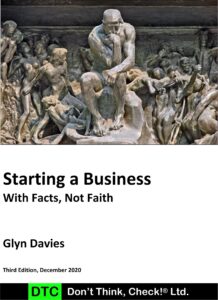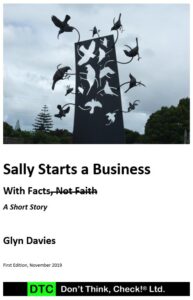
“Learning and innovation go hand in hand. The arrogance of success is to think that what you did yesterday will be sufficient for tomorrow.” William Pollard[1].
“Without change there is no innovation, creativity, or incentive for improvement. Those who initiate change will have a better opportunity to manage the change that is inevitable.”William Pollard[1].
The title of this post is an oxymoron. How can something be both enduring and transient? What if however, your business operations were taking advantage of endless waves of transient advantage? Would that make the title less non-sensical?
During many aspects of the business lifecycle, such as during idea exploration, experimenting with proposals, and then building, managing, and growing the business, many assumptions are in play.
I am a firm believer that there is often a significant difference between objective reality (the truth), and assumptions. The difference in practice manifests as the difference in results between being able to predict outcomes with a high degree of accuracy and precision, and that of pure guesswork, luck, and consigning results to fate.
In business, the difference between the truth and assumptions can result in the difference between a successful and a failed business.
There is a persistent tacit assumption in business, at least as evidenced by people’s behaviours, though not necessarily by what they espouse. The assumption (or hope) is that their business, market, or industry is static or is mostly unchanging.
Michael Porter’s popular Five Forces framework (and my adaptation) and its use is a case in point. Porter’s framework is a useful tool for industry structural analysis, but the tacit assumption behind the scenes is that the industry in question is largely static and that with judicious use of the framework you should be able to define a sustainable competitive advantage. I’m an advocate of this framework, as it’s very useful. However, it’s not obvious that you should be revisiting Porter’s framework periodically (monthly say) to ensure that changes on the horizon, or in your face for that matter, are likely to put your assumptions and things that you depend on in your business at risk.
Our values influence our assumptions and beliefs, which in turn influence what we do, such as how you build your business. If you assume that the business world, at least in your market, is relatively static or slow-changing, then you will design your business accordingly. If on the other hand, your assumption, or better yet your objective analysis, has shown that your market is not slow-changing, then you will design your business differently.
Designing a business is a significant undertaking, involving developing a Business Model, establishing a structure, obtaining assets, and hiring employees, to list a few. Once we have invested time, effort, and capital, we are loath to change things, especially if the business is running well enough and the flexibility to change things was not baked in at the outset.
The point is, legacy business systems were made for and reinforce legacy structures and operations, and are therefore unlikely to be suitable for what is needed in a changing business environment. And further, unless agility, meaning the ability and willingness to adapt to a changing business environment it designed into a business, a business is unlikely to survive for long.
When we build a business to take advantage of a Business Model opportunity, we need to build it in such a way that while exploiting the opportunity, resources are also being invested in searching for, proving, and preparing for the next opportunity.
A helpful metaphor is surfing waves, where the surfer is a business riding a wave of opportunity on a board representing competitive advantage. Ultimately the wave of opportunity will diminish and peter out, but the idea is to watch out for and catch the next wave before the current wave is exhausted. The wave metaphor is useful, but as a model, it has its limits as a business, especially a larger business may be able to ride multiple waves at once.
In business, as in surfing, there will be competitors trying to catch your wave and if they can, they will capture market share and in effect, either damage or knock you from your board.
A business fends off usurpers by developing better products, services, and experiences (solutions) for sale than its competitors. But this is like an escalating arms race – eventually, competitors will improve their offerings and the cycle begins anew. Successful businesses provide better value today and every day. However, competitors are likely to be relentless.
The looking for, catching, and riding the waves of opportunity are what is known as business innovation. But one has to be careful when speaking about innovation because the way some people talk about it is like saying, “give me a bunch of innovation, with a hurry up and get it done now on the side, all the while doing your day job as well.”
Innovation is not a silver bullet (as used to kill werewolves) solution to wound or kill fellow surfers. Innovating is hard. The act of innovating successfully, and by that I mean, deliberately and repeatedly catching and riding waves of opportunity, cannot be left to executive pronouncement alone. The will and capability to innovate need to be designed into a business, that is, baked in. Doing otherwise, innovation activities are likely to be episodic, idiosyncratic, and halfhearted without ever leading to satisfactory business outcomes. In short, innovation activities should not be left to chance.
What are areas of the business most likely in need of innovation? Is it in the areas of exploiting existing opportunities, improving efficiency, creating growth, or transformation? An essential aspect of innovating is that it should not be random, but instead, innovating should be guided, as many unguided efforts end up down avenues that can’t be economically monetised. Furthermore, change can originate within an industry such as the impact of colour pictures within the film photography industry, or from another industry, such as digital information storage and its effect on the invention of digital photography.
In summary, the business world changes – markets and industries are rarely static for long. Opportunities come, opportunities have their run, and then they diminish and often peter out altogether. Any current competitive advantage is likely to be unsustainable in the long-term. The question business people need to ask is, how quickly is my market or industry changing or likely to change? What ripples of change are on the horizon in my industry or other industries that may create waves of opportunity for me? And what can I do to prepare for the next wave?
As someone who has tried to surf, I can vouch for the notion of keeping an eye out for the on-coming waves – missing out on waves can be disappointing, as can catching a wave ill-prepared and being slammed into the rocks of failure.
This
post is based on my consulting work and Rita McGrath’s 2013 book titled The End of Competitive Advantage – how to
keep your strategy moving as fast as your business.
[1] William Pollard, physicist. https://www.inspiringquotes.us, Jan 2020.
#DontThinkCheck #BusinessResultant #StartMyBusiness #RunMyBusiness



